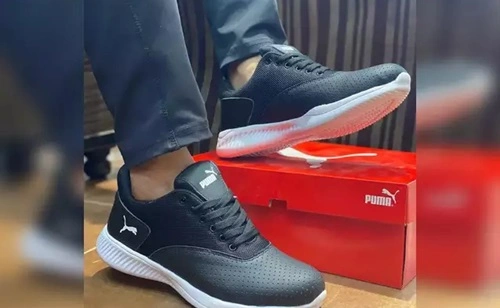Puma is one of the most recognized sportswear brands in the world, known for its high-quality footwear, stylish designs, and comfortable fit. However, the popularity of Puma shoes has led to an increase in counterfeit products in the market. Fake Puma shoes are often sold at lower prices, but they lack the quality, durability, and comfort of the original ones. If you want to ensure that you are buying genuine Puma shoes, it is important to know how to check their authenticity.
In this guide, we will discuss the key methods to identify original Puma shoes and differentiate them from fake ones.
1. Buy from Authorized Sellers

The safest way to get original Puma shoes is by purchasing them from official Puma stores, authorized retailers, or reputable e-commerce platforms like:
- Puma’s official website (www.puma.com)
- Authorized sportswear stores such as Reliance Trends, Lifestyle, and Metro Shoes.
- Trusted online platforms like Amazon, Flipkart, Tata Cliq, or Myntra (ensure that the seller is “Puma Official” or a verified seller).
If a seller is offering Puma shoes at a very low price or selling them without proper packaging, it is likely that they are counterfeit.
2. Check the Puma Shoe Box and Packaging
Original Puma shoes always come in high-quality packaging. Here’s how you can check:
- The box should be sturdy and well-designed, featuring the Puma logo and branding.
- There should be a barcode, model number, and manufacturing details on the box.
- The Puma logo should be perfectly printed without any smudging or fading.
- Fake Puma shoes often come in cheap cardboard boxes, and the printing on them may look blurry or misaligned.
3. Examine the Puma Logo
One of the easiest ways to identify fake Puma shoes is by checking the logo:
- The Puma cat logo should be sharp, detailed, and properly printed or embossed.
- The font and spacing of the brand name “PUMA” should be consistent across the shoe.
- Fake Puma shoes may have:
- A distorted or misaligned logo.
- Poor-quality printing with fading or smudging.
- Incorrect spelling of “PUMA” (e.g., “PUWA” or “PUNA”).
4. Check the Shoe’s Build Quality
Original Puma shoes are made with premium materials and excellent craftsmanship. Look for the following:
- Stitching Quality: The stitches should be neat, even, and strong. Fake shoes often have loose, uneven, or excess threads.
- Material Quality: Genuine Puma shoes are made from high-quality mesh, leather, or synthetic materials that feel smooth and durable.
- Sole and Cushioning: The sole should be flexible but sturdy, and the insole should be soft with proper cushioning for comfort.
- Weight of the Shoe: Original Puma shoes have a balanced weight, whereas fake shoes may feel too light or heavy due to cheap materials.
5. Verify the Size Tag and Label
Inside the original Puma shoes, there is a size tag with important information. Here’s what to check:
- The tag should include:
- The Puma logo
- Shoe size (US, UK, EUR, CM)
- Model number
- Manufacturing date and location
- A barcode or QR code
- Check for Printing Clarity: Original Puma shoes have a clearly printed size tag, while fake ones often have faded or blurry text.
6. Perform the Barcode and Serial Number Check
- Every original Puma shoe has a unique barcode and serial number.
- Scan the barcode using a QR code scanner or barcode reader app on your smartphone.
- The barcode should direct you to Puma’s official website or provide accurate product details.
- If the barcode doesn’t scan or leads to an unknown page, the shoes are likely fake.
7. Examine the Outsole and Midsole
- The Puma outsole should be made from high-quality rubber with well-defined patterns for better grip.
- Fake Puma shoes often have poorly designed soles with weak grip and improper alignment.
- Check for the Puma logo on the sole, which should be clear and properly embossed.
8. Check the Laces and Eyelets
- Original Puma shoes come with strong, high-quality laces that do not fray easily.
- The eyelets (holes for laces) should be evenly placed and properly finished.
- Fake Puma shoes may have loose or uneven eyelets and poor-quality laces that wear out quickly.
9. Look for Comfort and Fit
- Puma is known for its comfortable fit and superior support.
- If the shoes feel too hard, uncomfortable, or poorly cushioned, they might be fake.
- Original Puma shoes provide proper arch support, whereas fake ones often feel stiff and flat.
10. Compare with Puma’s Official Website
- Before purchasing, compare the design, colors, and product details with those listed on Puma’s official website.
- If the design doesn’t match or the color combination looks unusual, it might be a counterfeit product.
11. Check the Return and Warranty Policy
- Original Puma shoes come with a return or exchange policy when bought from official stores or authorized sellers.
- Fake sellers often do not provide a proper return policy.
- Puma also offers a manufacturer’s warranty, which fake shoes will not have.
Final Thoughts
Checking the authenticity of Puma shoes is essential to ensure you get the best quality, durability, and comfort. Always buy from trusted sources, examine the packaging, verify the logo and serial number, and inspect the shoe’s quality and design. Fake Puma shoes may look similar at first glance, but careful examination will reveal major differences in build quality, comfort, and branding.
By following these steps, you can confidently buy genuine Puma shoes and avoid wasting money on counterfeits. Always invest in authentic products to enjoy the true comfort, style, and durability that Puma offers.